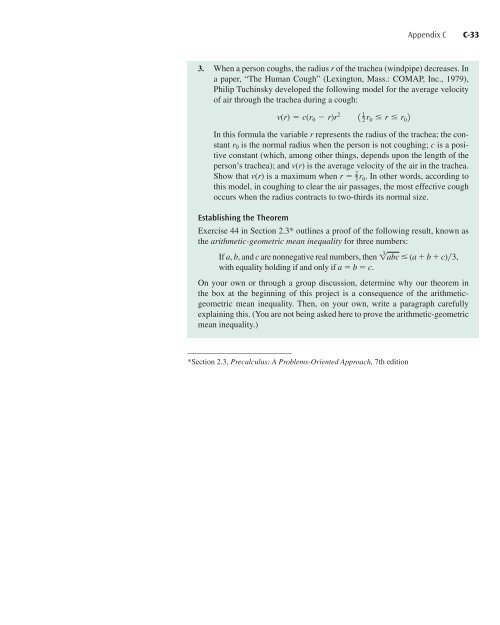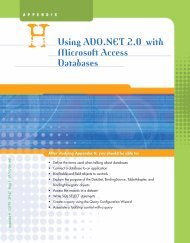You also want an ePaper? Increase the reach of your titles
YUMPU automatically turns print PDFs into web optimized ePapers that Google loves.
Appendix C C-33<br />
3. When a person coughs, the radius r of the trachea (windpipe) decreases. In<br />
a paper, “The Human Cough” (Lexington, Mass.: COMAP, Inc., 1979),<br />
Philip Tuchinsky developed the following model for the average velocity<br />
of air through the trachea during a cough:<br />
v(r) c(r 0 r)r 2 1<br />
1 2 r 0 r r 0 2<br />
In this formula the variable r represents the radius of the trachea; the constant<br />
r 0 is the normal radius when the person is not coughing; c is a positive<br />
constant (which, among other things, depends upon the length of the<br />
person’s trachea); and v(r) is the average velocity of the air in the trachea.<br />
2<br />
Show that v(r) is a maximum when r 3 r 0. In other words, according to<br />
this model, in coughing to clear the air passages, the most effective cough<br />
occurs when the radius contracts to two-thirds its normal size.<br />
Establishing the Theorem<br />
Exercise 44 in Section 2.3* outlines a proof of the following result, known as<br />
the arithmetic-geometric mean inequality for three numbers:<br />
If a, b,andc are nonnegative real numbers, then 1 3 abc (a b c)3,<br />
with equality holding if and only if a b c.<br />
On your own or through a group discussion, determine why our theorem in<br />
the box at the beginning of this project is a consequence of the arithmeticgeometric<br />
mean inequality. Then, on your own, write a paragraph carefully<br />
explaining this. (You are not being asked here to prove the arithmetic-geometric<br />
mean inequality.)<br />
*Section 2.3, Precalculus: A Problems-Oriented Approach, 7th edition
















